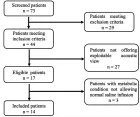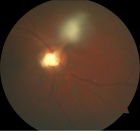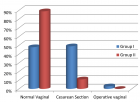Table of Contents
Visualization and Evaluation of Changes after Rapid Maxillary Expansion
Published on: 30th March, 2017
OCLC Number/Unique Identifier: 7286430438
Objectives: The aim of the study was to develop a mathematical model for the visualization and evaluation of transversal palatal soft tissue changes; and to carry out a statistical evaluation of the changes in vertical and sagittal dimensions after rapid maxillary expansion treatment.
Material and Methods: 33 Caucasian children with posterior crossbite, 10 boys and 23 girls, aged 7 to 10 years (median 8 years 8 months) were treated with tooth-borne Haas type expander. Dental casts were digitalized by scanner and on the basis of quantitative mesh shape CPD-DCA analysis, coloured morphometrical maps were created. The statistical significance of individual vertex displacements was calculated by performing Hotelling’s T2 paired test. To determine the significance of the vertical and sagittal profile changes, the paired t-test and Wilcoxon signed rank test were carried out in 20 patients
Results: Visualization of the palatal soft tissue widening showed it to be greatest in the areas of the second deciduous and first permanent molars with maximum of 0.75 mm for each palatal side. Hotelling’s T2 paired test showed significant differences of p<0.01 in transversal width dimension. Cephalometric measurements of the changes to vertical and sagittal dimensions were statistically evaluated using the Wilcoxon and paired t-tests, and were shown to have insignificant values of p>0.05.
Conclusion: The expansion appliance in children resolved the crossbite and led to palatal widening, which was clearly visualized by creating mathematical morphometric models. The cephalometric measurements carried out did not reveal statistically significant relevance in changes to facial vertical or sagittal dimensions.
Comparative Study of Enophthalmos Treatment with Titanium Mesh Combined with Absorbable Implant vs. Costochondral Graft for Large Orbital Defects in Floor Fractures
Published on: 23rd March, 2017
OCLC Number/Unique Identifier: 7286350491
Introduction: Several treatment options are available for the optimal treatment for orbital fractures, depending on aesthetic and functional results after orbital wall reconstruction. The objective of this study is to compare the effect and safety of large orbital floor fractures with titanium mesh combined with poly-L-lactic acid/polyglycolic acid copolymer implants (Lactosorb®) vs. autologous costochondral graft. A wide range of permanent and biodegradable materials have been used successfully for orbital floor reconstruction, however they present with disadvantages for reconstruction of large defects, even if combined.
Patients and Methods: A retrospective cohort study of patients from Estado de México, México, with access to ISSEMYM health care service, presenting with orbital floor fracture treated at Department of Plastic & Reconstructive Surgery/Maxillofacial Surgery at ISSEMYM Medical Center Toluca between January 2007 and July 2010. Age, sex, etiology, clinical findings, fracture pattern, and treatment modality (Titanium mesh with absorbable implant vs. costochondral graft) were considered. Predictor and outcome variables as complications, inpatient, trauma- surgery interval, surgical time and donor site pain are considered.
Results: Follow up of 21 patients (12 weeks) 17 male, 4 female, ages 22-63 was made. Enophthalmos, main objective of this study, was identified with statistical significance presenting 0% (n=0) post-op Group B patients and 30% (n=3) for Group A (p=0.049). Statistical significance was found referring to inpatient days between two groups being less for costochondral reconstruction patients (p=0.02). No pain in patients undergoing alloplastic surgery. An interesting result was that donor area analogue pain scale for costochondral graft was 2.9/10.
Conclusion: Surgical outcome and complications where evaluated comparing different materials for orbital floor reconstruction. Costochondral graft is a suitable choice when orbital reconstruction is indicated.
Normal Value of Skull Base Angle Using the Modified Magnetic Resonance Imaging Technique in Thai Population
Published on: 20th March, 2017
OCLC Number/Unique Identifier: 7286350678
Purpose: To determine the normal value of basal angle measured using the modified MR imaging technique in Thai population compared with the standard value obtained from the Western population.
Material and Methods: We retrospectively evaluated midline sagittal SE T1 weighted MR images in 200 adults and 50 children. The basal angle of the skull base was measured using the modified MR imaging technique described by Koenigsberg et al. The angle was formed by a line extending across the anterior cranial fossa to the tip of the dorsum sellae and another line drawn along the posterior margin of the clivus. The mean values of the basal angles among different age groups and sex were calculated and analyzed.
Results: The mean skull base angle of our adult population was 115° (range 100.5°-130°, SD=5.7) with an inter-observer agreement of 0.85, slightly smaller than the previous study from the USA which was 117°. There was no significant difference between the male and female groups. The mean skull base angle in our children population was 114.7° (range 102- 130.5°, SD=6.3) with an inter-observer agreement of 0.89, quite similar to the previous USA study which was 114°. There was no significant difference between adult and children.
Conclusion: The mean adult skull base angle measured using the modified MR imaging technique in Thai population was slightly smaller than the Western population, while the mean skull base angle of children was quite similar. The basal angle range of 103.6°-126.4° may be used as a guide for the potential range of normal skull base angles in Thai population and possibly also the Southeast Asian population.
Evaluation of Horizontal Lip Position in Adults with Different Skeletal Patterns: A Cephalometric Study
Published on: 10th March, 2017
Aim: To evaluate sexual dimorphism in horizontal lip position in adults with different skeletal patterns.
Material and Methods: The sample comprised of 120 patients (Females 18 years and above, Males 21 years and above) with no history of previous orthodontic treatment or functional jaw orthopaedic treatment. They were divided into different groups based on the ANB angle and gender. Group I and II included 30 males and 30 females with skeletal class I malocclusion (ANB 0-4 degree). Group III and IV included 30 males and 30 females with skeletal class II malocclusion respectively (ANB above 4 degree).
Results: When comparison between males and females (Class I+Class II) was done S-line (p<0.001), B-line (p<0.001), E-line (p<0.001), Holdaways angle (p<0.001) and Merrifield angle (p<0.001) were found to be statistically significant. S-line (p<0.001), E-line (p<0.001) and Holdaways angle (p<0.001) were found to be statistically significant when comparison was done between males and females (Class I). When comparison was done between males and females (Class II) only Holdaways angle (p<0.001) showed a significant statistical difference.
Conclusion: Sexual dimorphism was found in various lip parameters. Significant amount of differences were found between Class I and Class II (male and female) subjects.

If you are already a member of our network and need to keep track of any developments regarding a question you have already submitted, click "take me to my Query."
















































































































































